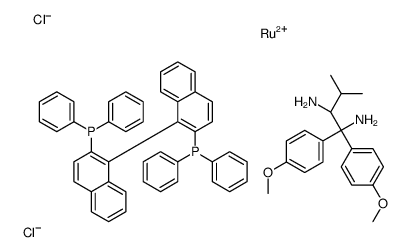212143-24-3
| Name | (2S)-1,1-bis(4-methoxyphenyl)-3-methyl-butane-1,2-diamine, dichlo roruthenium, [1-(2-diphenylphosphanyl-1-naphthyl)-2-naphthyl]-dip henyl-phosphane |
|---|---|
| Synonyms |
RuCI2[(R)-BINAP][(R)-DAIPEN]
Dichloro[(R)-(+)-2,2 inverted exclamation marka-bis(diphenylphosphino)-1,1 inverted exclamation marka-binaphthyl][(2R)-(-)-1,1-bis(4-methoxyphenyl)-3-methyl-1,2-butanediamine]ruthenium(II) RuCI2[(S)-BINAP][(S)-DAIPEN] |
| Molecular Formula | C63H58Cl2N2O2P2Ru |
|---|---|
| Molecular Weight | 1109.07000 |
| Exact Mass | 1108.24000 |
| PSA | 97.68000 |
| LogP | 7.47440 |
|
Section 1: Product Identification Dichloro[(S)-(-)-2,2'-bis(diphenylphosphino)-1,1'-binaphthyl][(2S)-(+)-1,1-bis(4-methoxyphenyl)-3-methyl-1,2-b Chemical Name: utanediamine]ruthenium (II) dichloromethane adduct, min CAS Registry Number:212143-24-3 Formula:C63H58Cl2N2O2P2Ru EINECS Number:none
Chemical Family:organometallic complex Synonym:Ruthenium [(S)-BINAP] [(S)-DAIPEN] Section 2: Composition and Information on Ingredients IngredientCAS NumberPercentACGIH (TWA)OSHA (PEL) Title compound212143-24-3100%no datano data Section 3: Hazards Identification Emergency Overview:No particular hazard associated with this material. Primary Routes of Exposure:Ingestion Eye Contact:May cause irritation to the eyes Skin Contact:May cause slight to mild irritation of the skin. Inhalation:Inhalation is an unlikely source of exposure. Ingestion:No information is available on the physiological effects of ingestion. Other than a possible irritant, no information is available on the acute health effects of exposure to this Acute Health Affects: material. Chronic Health Affects:No information available on long-term chronic effects. NTP:No IARC:No OSHA:No SECTION 4: First Aid Measures Immediately flush the eyes with copious amounts of water for at least 10-15 minutes. A victim may need Eye Exposure: assistance in keeping their eye lids open. Get immediate medical attention. Wash the affected area with water. Remove contaminated clothes if necessary. Seek medical assistance if Skin Exposure: irritation persists. Remove the victim to fresh air. Closely monitor the victim for signs of respiratory problems, such as difficulty Inhalation: in breathing, coughing, wheezing, or pain. In such cases seek immediate medical assistance. Seek medical attention immediately. Keep the victim calm. Give the victim water (only if conscious). Induce Ingestion: vomiting only if directed by medical personnel. SECTION 5: Fire Fighting Measures Flash Point:none Autoignition Temperature:none Explosion Limits:none Extinguishing Medium:carbon dioxide, dry powder or foam If this material is involved in a fire, fire fighters should be equipped with a NIOSH approved positive pressure Special Fire Fighting Procedures: self-contained breathing apparatus and full protective clothing. Hazardous Combustion andIf involved in a fire this material may emit toxic organic fumes. Decomposion Products: Unusual Fire or Explosion Hazards: No unusual fire or explosion hazards. SECTION 6: Accidental Release Measures Spill and Leak Procedures:Small spills can be mixed with vermiculite or sodium carbonate and swept up. SECTION 7: Handling and Storage The material will degrade on prolonged exposure to air. Store under an inert atmosphere of nitrogen or argon. Handling and Storage:Keep bottle tightly sealed and away from heat and direct sunlight. For prolonged storage keep material refrigerated. SECTION 8: Exposure Controls and Personal Protection Eye Protection:Always wear approved safety glasses when handling a chemical substance in the laboratory. Skin Protection:Wear protective clothing and gloves. Ventilation:If possible, handle the material in an efficient fume hood. If ventilation is not available a respirator should be worn. The use of respirators requires a Respiratory Respirator: Protection Program to be in compliance with 29 CFR 1910.134. Ventilation:If possible, handle the material in an efficient fume hood. Additional Protection:No additional protection required. SECTION 9: Physical and Chemical Properties Color and Form:white to pale yellow powder Molecular Weight:1109.10 Melting Point:>100° (dec) Boiling Point:decomposes Vapor Pressure:not applicable Specific Gravity:no data Odor:none Solubility in Water:insoluble SECTION 10: Stability and Reactivity Stability:air-sensitive solid (store cold) Hazardous Polymerization:none Conditions to Avoid:none Incompatibility:strong oxidizing agents carbon dioxide, carbon monoxide, hydrogen chloride, phosphorus pentoxide, nitrogen oxides, organic fumes, Decomposition Products: and ruthenium salts SECTION 11: Toxicological Information RTECS Data:No data available in the RTECS files Carcinogenic Effects:No data available Mutagenic Effects:No data available Tetratogenic Effects:No data available SECTION 12: Ecological Information Ecological Information:No information available SECTION 13: Disposal Considerations Disposal:Dispose of according to local, state and federal regulations. SECTION 14: Transportation Shipping Name (CFR):Non-hazardous Hazard Class (CFR):NA Additional Hazard Class (CFR):NA Packaging Group (CFR):NA UN ID Number (CFR):NA Shipping Name (IATA):Non-hazardous Hazard Class (IATA):NA Additional Hazard Class (IATA):NA Packaging Group (IATA):NA UN ID Number (IATA):NA SECTION 15: Regulatory Information TSCA:not listed on the TSCA inventory SARA (Title 313):not regulated by Title 313 Second Ingredient:none SECTION 16 - ADDITIONAL INFORMATION N/A |
| Safety Phrases | S22-S24/25 |
|---|
